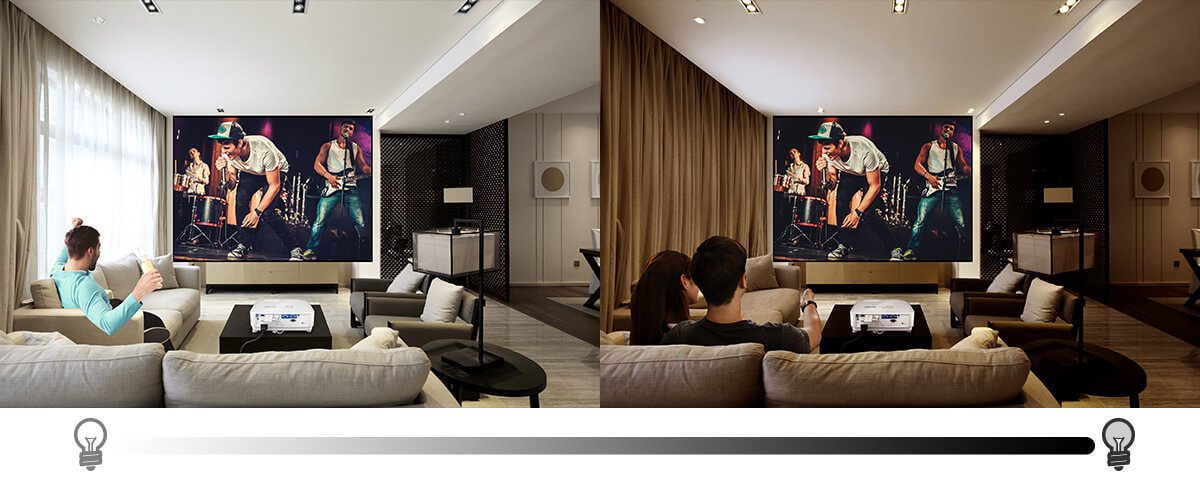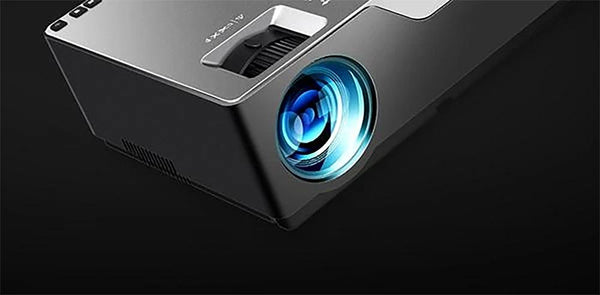Shedding Light on Projector Brightness: How Much is Right?
Introduction
The quality of visual experience primarily depends on the fundamental factor of brightness for any projector. Regardless if it's for professional presentations or a captivating movie night at home, getting the right projector brightness is essential. This article will help you understand the meaning of projector brightness, its significance, and how to adjust it to achieve optimal viewing.
What Exactly Does Projector Brightness Refer To?
Projector brightness is a significant feature that users often grapple with when choosing a projector device. But what is projector brightness?
- Essentially, projector brightness is the measurement of light output from a projector, calculated in a unit called lumens.
- The main job of this feature is to regulate the brightness of the projected images on a screen. A higher lumen rating usually equates to a brighter display.
- However, keep in mind that achieving 'ideal’ projector brightness isn’t about selecting the highest lumens value available. Rather, it's about striking an optimal balance suitable to your particular use and environment.
Let's illustrate this with an analogy. Imagine projector brightness as the sunlight on a clear day. A high noon sun (equating to high lumens) may cause you to squint and be uncomfortable. On the other hand, a setting sun (representing low lumens) might not provide enough light to see clearly. This illustrates why achieving a 'perfect' balance in projector brightness (akin to a pleasant morning sun) is key for the best viewing experience.
In conclusion, understanding projector brightness is not just about lumens. It's about how you adjust these lumens to meet your specific displaying needs and fit the environment you're in.
Why is the Right Brightness Level Crucial for Projectors?
Establishing the right level of brightness for your projector is crucial for various reasons. The significance should never be underestimated, mainly due to its direct impact on the quality of the viewing experience.
Maintaining Balance Between Dark and Light
Projector brightness is a delicate balance that one needs to maintain. If the level is set too low, the result is an image that is dull and difficult to see. Conversely, if it is too high, the image may appear washed out, lacking in depth and detail. Striking the right balance ensures that the image is neither too bright nor too dark, allowing for an optimal viewing experience.
Preventing Eye Strain
User comfort is another vital factor to consider when adjusting projector brightness. Poor brightness settings can lead to significant discomfort and eye strain over prolonged periods, negatively impacting productivity during meetings or enjoyment during movie nights.
Ensuring Clarity and Vividity
Lastly, ideal brightness levels contribute to sharper, clearer, and more vivid visuals. By achieving the right brightness balance, you can ensure that the projected images or videos maintain their original color and contrast quality.
H4: Bottom-line
The perfect balance of projector brightness is vital to enhance the overall viewing experience. Too low or too high brightness levels can hinder the quality of the visuals, comfort of the viewer, and ultimately, the purpose of using the projector. Therefore, understanding and appropriately adjusting projector brightness is a requisite for optimal projector performance.
How Does Lumens Measure Projector Brightness?
When attempting to comprehend how brightness is gauged for projectors, you'll inevitably encounter the term 'lumens'. To clarify, lumens are a standard unit of measure indicating the total amount of visible light a source produces. In the context of projectors, think of lumens as the quantity of light directed towards a screen or other surface.
While it might be tempting to equate higher lumens with better visual quality, it's important to note that this isn't always the case. Here's why:
- Brightness ≠ Quality: While a brighter image (high lumens) ensures good visibility, especially in light-filled environments, it doesn't guarantee optimal image quality. Color accuracy and contrast ratios, which aren't covered by the lumens measurement, are also vital for high-quality visuals.
- Overly Bright Images: An excessively bright image can wash out colors and textures. Hence, a projector with an astronomically high lumens rating might not provide a better viewing experience.
Nevertheless, if you frequently find yourself in situations where there’s substantial ambient light, higher lumens projectors can be preferable for their capacity to 'outshine' the surrounding light.
In essence, while lumens do provide a useful indication of a projector's light output, they aren't the sole arbiters of image quality. Always bear in mind that they must be considered alongside other critical factors, such as contrast ratio, color accuracy, and the display environment, to guarantee a truly superior visual experience.
What Factors Determine the Ideal Brightness Level for Your Projector?
The selection of a suitable brightness level isn't a universal solution but varies based on several elements. Understanding these elements will ensure you choose the correct lumens value suited to your requirements and environment.
- Size of the Display Area: The scope of your display area largely influences brightness. Mainly, more expansive spaces will need a projector with a higher brightness level. A 2500 lumens projector may work well for a small conference room, but a large auditorium might require something closer to 4000 lumens for a clear image.
- Ambient Light: The level of ambient light in your space plays a critical role in determining the ideal brightness. Brightly lit rooms require a higher brightness projector to combat light interference, ensuring visible and clear pictures. In contrast, a dimly lit or dark room would require significantly fewer lumens.
- Content Type: Different types of content demand different brightness levels. For example, detailed data, such as graphs or text, require a brighter projection for better visibility. Films or videos, on the other hand, might be better enjoyed with a dimmer projection, allowing for richer colors and contrast.
- Screen Material: The type of surface you're projecting onto also matters. A reflective surface, for example, would typically require less brightness as it bounces more light back to the audience. In contrast, a darker or absorbent surface might require a more luminous projection.
Paying attention to these factors will aid in optimizing your viewing experience by ensuring you have the appropriate projector brightness for your specific scenario. Brightness isn't just about having the highest lumens value but finding the right balance based on your needs and environment.
How to Adjust Projector Brightness for Different Environments?
When considering a projector's brightness, taking into account different viewing environments is critical. Modifying projector brightness often involves assessing the ambient light and adjusting the projector's settings. Below are some tips on how to refine your projector's brightness to cater to different environments.
1. Consider Your Ambient Light: The presence of external light in your space significantly impacts the projector's brightness. For rooms with high ambient light, choose a projector with a higher lumens value. In contrast, spaces with low light may benefit from a projector with fewer lumens.
2. Adjust the Projector's Settings: Modern projectors often come with adjustable brightness settings, enabling you to fine-tune the brightness and contrast ratio for optimal viewing. Take advantage of these features and adjust the settings according to the room's light conditions and the content on screen.
3. Assess Your Content: The projected content itself can steer your brightness settings. Detailed visuals usually require brighter projections for clarity and readability, while videos or films benefit from lower brightness to preserve the depth of field and contrast.

4. Be Mindful of Screen Size and Distance: The larger the screen and the greater the distance, the higher must be the brightness. Use this as an added factor when tuning the brightness level.
In conclusion, adjusting the projector brightness is not a one-size-fits-all scenario but a balance of various factors. Remember, the ultimate aim is to ensure that the projected image is clear, vibrant, and easy on the eyes.
Conclusion
Understanding and adjusting the projector brightness is paramount to enhance your visual experience. Though the lumen value plays a significant role, equal importance should be placed on the factors determining brightness and how to adjust it accordingly. Always bear in mind, the ultimate goal is to achieve vibrant, clear, and strain-free imagery for the viewer.
Related FAQs about what is a good brightness for a projector
Is there a universal standard for 'good' brightness of a projector?
No, there is no universal standard for projector brightness. The ideal brightness levels depend on various factors such as the ambient light, the size of the display area, type of content being displayed, and screen material. It's about finding the right balance based on your specific needs and environment.
Are higher lumens always better for projector brightness?
Not necessarily. Higher lumens indicate a brighter projection, which can be beneficial in certain environments, such as well-lit spaces. However, excessive brightness can compromise image quality, wash out colors and cause viewer discomfort. Therefore, it’s crucial to consider other factors like contrast ratio and color accuracy.

How can I adjust the brightness of my projector based on ambient light?
Consider the environment where you're using the projector. In rooms with high ambient light, opt for a projector with a higher lumens value. Conversely, in low light spaces, a projector with fewer lumens will suffice. Many modern projectors have adjustable brightness settings which can be fine-tuned based on these conditions.


